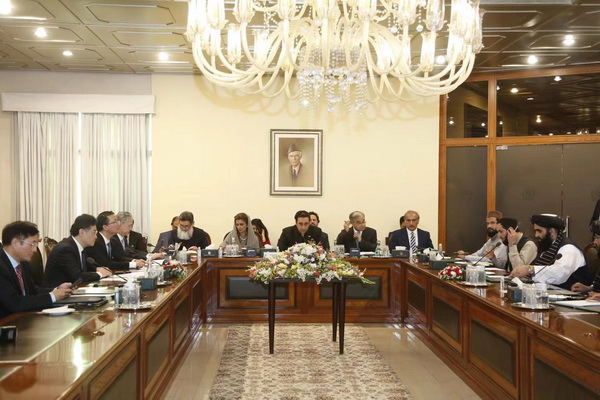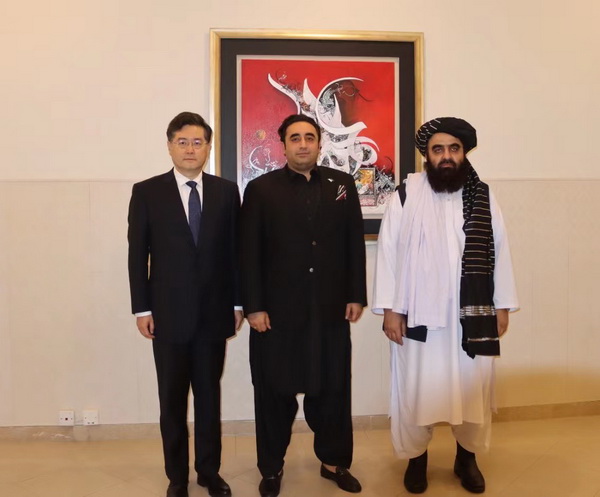China has been the main supporter of Afghanistan since decades. Even during the invasion of Afghanistan, China had played a key role in promoting peace and initiated several infrastructure projects to uplift the fragile economic situation of the country. Moreover, a new chapter has been opened in relation between Afghanistan and China as well as between Afghanistan and Pakistan after the regime changed. The ties between the three neighbors seemed unprecedentedly boosted after the victory of the Taliban in August 2021 when the foreign troops accepted defeat and made a hasty withdrawal after 20 years of presence.
China as an important neighbor to Afghanistan and a powerful country in the world has often extended helping hands to Afghanistan and exhibited a strong intention to help improve the country’s security and economy. To reach that goal, China didn’t freeze its diplomatic mission in Kabul after the collapse of the previous government and at the same time did not recognize the Taliban government officially. The point is that China understands the gravity of the situation and it wants to help the Afghan people at the most difficult time caused by the chaotic and irresponsible drawdown of foreign forces.
Beijing has never stopped supporting Afghanistan with a population of an estimated 35 million, who are going through extreme poverty due to the flop policy of the western countries, especially the US on top of that.
Someone needs to ask the US that what was the outcome of 20 years of presence in Afghanistan and where the billions of dollars had been spent? There is no need to touch on the political arena but in economic aspects, the US must come up to the fore with a clear explanation. Surely, the US has no reasonable clarification and would never be able to put in plain words what has exactly happened in Afghanistan and why the economy is so bad.
It is worth mentioning that Afghanistan is not a poor country as it has three billion dollars underground resources only and other billions of precious capitals. Afghanistan is also called the “Heart of Asia” and geo-politically it is located in the most strategic quarter.
Nevertheless, Afghanistan still has a strong country on its side and that is China. Afghanistan needs China and Beijing as a neighbor has been making all out efforts to make Afghanistan stand on its own feet.
China will always stand firmly with Afghan people
China Foreign Minister Qin Gang met with Afghan Foreign Minister Amir Khan Muttaqi in Islamabad, Pakistan, where he said that “China and Afghanistan are traditionally friendly neighbors connected by mountains and rivers.”
He said that both the countries have been supporting, understanding and trusting each other. “No matter how international and regional situations evolve, China will always stand firmly with the Afghan people and support Afghanistan in pursuing a development path that suits its national conditions,” he added.
Qin furthered that “China will, as always, respect Afghanistan’s sovereignty, independence and territorial integrity, deepen China-Afghanistan cooperation in various fields, and help Afghanistan realize self-reliance, peace, stability, development and prosperity at an early date.”
Belt and Road Initiative to Afghanistan
The Afghan Foreign Minister Muttaqi during a meeting with his Chinese counterpart said that Afghanistan attaches great importance to developing relations with China and will never allow any force to use the Afghan territory for anti-China activities.
The Taliban also expressed eagerness to be part of the Belt and Road Initiative (BRI) to Afghanistan, potentially drawing in billions of dollars to fund infrastructure projects in the country.
“Afghanistan hopes to strengthen cooperation with China in such fields as economy, trade, cultural and people-to-people exchanges and infrastructure development within the framework of the Belt and Road Initiative to safeguard the common interests of the two sides and benefit the two peoples,” Muttaqi told Qin Gang.
He added that Afghanistan hopes to live in harmony with China, Pakistan and other neighboring countries and is ready to actively promote Afghanistan-China-Pakistan trilateral cooperation to promote regional stability and prosperity.
During the meeting, Qin Gang emphasized that Afghanistan should earnestly fulfill its commitment to fighting terrorism, resolutely crack down on terrorist forces, including the East Turkistan Islamic Movement, and ensure the safety and security of Chinese personnel and institutions in Afghanistan.
“China will continue to advance the China-Afghanistan-Pakistan trilateral dialogue and cooperation based on the principles of equal consultation, practical cooperation and friendship, mutual benefit and win-win results,” he added.
China invests $2b since two years in Afghanistan
China has signed $2 billion contracts on several economic projects since the return of the Taliban to power in August 2021, and these investments are mainly in areas of extraction of mines, services at airports and industrial parks.
A spokesman for the Ministry of Industry and Commerce Abdul Salam Jawad said that there are several Chinese companies that are also active in Afghanistan where 21 of them are only based in Kabul, the capital city. Jawad said that a number of Chinese investors held a meeting with the deputy Minister of Industry and Mines and discussed important aspects on the investment sites.
There is also an expectation that China will include Afghanistan in China-Pakistan Economic Corridor (CPEC) and rename the project to China-Afghanistan-Pakistan Economic Corridor (CAPEC). There is no official confirmation on the news, but apparently China is working to include Afghanistan in all big projects as part of regional connectivity, improve cross-border trading, enhance the economic integration and achieve sustainable development. CPEC is a $60 billion project and China’s foreign minister vowed to work for reconstruction of Afghanistan including its inclusion in BRI which CPEC is part of that.
Three neighbors agree to boost security and economic cooperation
On Saturday, China, Afghanistan and Pakistan agreed to deepen ties and enhance cooperation in counter-terrorism and economic cooperation to boost regional stability. The foreign ministers of the three sides made the pledge at the 5th China-Afghanistan-Pakistan Foreign Ministers’ Dialogue in Islamabad, where China’s Qin Gang, Afghan’s Muttaqi and Pakistan’s Bilawal Bhutto Zardari seemed happy on the outcome of the meeting as they vowed more cooperation in different fields.

The fifth China-Afghanistan-Pakistan Foreign Ministers’ Dialogue was held in Islamabad, Pakistan.
During the session, Qin said that China has been attaching great importance to the friendship with Afghanistan and Pakistan, and is willing to work with the two sides to implement the “Global Development Initiative, the Global Security Initiative and the Global Civilization Initiative,” share development opportunities, jointly meet security challenges, and promote regional stability and prosperity.
Qin also asked Afghanistan and Pakistan to further strengthen the security measure for Chinese people working in the two countries. He also stressed the importance of anti-terrorism cooperation, saying China firmly opposes any form of terrorism and is ready to step up cooperation in fighting terrorism under regional multilateral frameworks including the coordination and cooperation mechanism among Afghanistan’s neighboring countries.
China also expressed readiness to strengthen development cooperation, share development opportunities and increase cultural and people-to-people exchanges with Afghanistan and Pakistan.
Afghanistan and Pakistan agree on bilateral cooperation
On their parts, Muttaqi and Bilawal agreed that the trilateral cooperation mechanism is of great significance to regional peace and prosperity, and both sided pledged to actively promote the trilateral cooperation, formulate a roadmap for political, security and economic cooperation to safeguard the common interests of the three countries, achieve mutual benefit, and bring benefits to the people of the three countries and other countries in the region.
Afghanistan foreign ministry spokesman Hafiz Zia Ahmad said that Muttaqi and Bilawal held a bilateral meeting in Islamabad, and both sides discussed political-economic, commercial, transit relations and the necessary aspects to provide facilities between the two countries.
He also said that both sides held a detailed discussion on the situation of Afghan refugees in Pakistan, and facilitated easy round trips for traders across the borders.
Relations between Afghanistan and Pakistan have never been easy and both sides accused each other of cross border shelling and terroristic activities. Since the return of the Taliban in 2021, there have been several clashes between the border guards of Afghanistan and Pakistan.
China presses for inclusive government in Afghanistan
China on Saturday pressed for the establishment of the inclusive government in Afghanistan, and called on the Taliban officials to pursue a moderate police force and have friendly relations with all the neighbors.
Speaking to reporters in Islamabad, Qin Gang called on the Taliban leaders to take bold steps in the fight against terrorism and take seriously the security concerns of its neighboring countries.
But the Taliban says they were able to establish an inclusive government and also there is no major threat posed to the neighbors from the soil of Afghanistan.
Taliban deputy spokesman, Bilal Karimi said that no one will be allowed to pose a threat to other countries from Afghanistan. He also said that the infrastructure of the government under the Taliban leadership is inclusive.

 OPINION2 weeks ago
OPINION2 weeks ago
 DIPLOMACY1 week ago
DIPLOMACY1 week ago
 DIPLOMACY6 days ago
DIPLOMACY6 days ago
 ASIA1 week ago
ASIA1 week ago
 DIPLOMACY7 days ago
DIPLOMACY7 days ago
 MIDDLE EAST2 weeks ago
MIDDLE EAST2 weeks ago
 MIDDLE EAST1 week ago
MIDDLE EAST1 week ago
 ASIA7 days ago
ASIA7 days ago


















